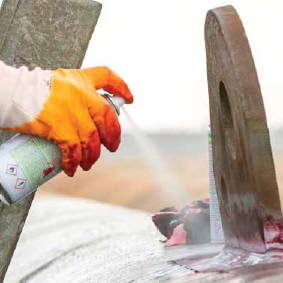Penetrant Testing (PT), also known as Liquid Penetrant Testing, is a highly versatile surface-based non-destructive testing (NDT) method. This technique employs a liquid containing a coloured dye, enhancing its visibility, to infiltrate and fill any open voids on the surface through capillary action. Once the excess penetrant is meticulously removed from the surface, a developer substance is applied. This developer acts as a contrasting medium, facilitating the migration of the penetrant from within the defects. Consequently, any discontinuities or flaws become prominently visible against the contrasting background, typically a white powder.
One of the remarkable attributes of PT is its applicability across a wide range of materials, provided that the discontinuity of interest is accessible from the surface. If you possess an affinity for chemistry, particularly the interplay of liquids, and find fascination in precision work that goes beyond swimming or indulging in the occasional beverage, then Penetrant Testing offers a fulfilling career path.
The effectiveness of PT is influenced by several factors, including the type of dye used (whether it’s designed for normal light or backlight conditions, or both), the specific penetrant employed, the method used to remove excess penetrant, and the developer chosen for the testing process. Additionally, PT techniques must adapt to extreme temperatures, as variations in temperature can affect liquid properties such as viscosity and evaporation. Specialised techniques are employed in cases of excessively high or low temperatures to ensure accurate and reliable results.
Embarking on a career in Penetrant Testing allows you to explore the fascinating intersection of chemistry, materials science, and meticulous precision, making it one of the fundamental and indispensable NDT methods in various industries.
IF YOU ENJOYED CHEMISTRY AT SCHOOL AND YOUR INTEREST IN LIQUIDS EXCEEDS THAT OF SWIMMING AND THE OCCASIONAL BEER, THEN WE INVITE YOU TO START YOUR CAREER IN ONE OF THE MOST BASIC YET USEFUL NDT METHODS.
Inspection techniques depend on whether the dye used is under normal light or backlight conditions (or both), the type of penetrant, excess penetrant removal process as well as developer used during testing. Furthermore, since temperature has an effect on the liquid properties, such as viscosity and evaporation, special techniques are applicable at excessively high and low temperatures.
The training course is based on general theory as well as sector specific applications relating, but not limited to, the following standards and specifications:
- ASME Boiler & Pressure Vessel Code – Section V – Subsection A – Article 1 & 6
- ASME Boiler & Pressure Vessel Code – Section V – Subsection B – Article 24
- ISO 3452 Parts 1 PT – General Principals
- ISO 3452 Parts 2 PT – Testing of penetrant materials
- ISO 3452 Parts 3 PT – Reference test blocks
- ISO 3452 Parts 4 PT – Equipment
- ISO 3452 Parts 5 PT – Testing at temperatures > 50 °C
- ISO 3452 Parts 6 PT – Testing at temperatures < 10 °C
- ISO 12706 PT – Vocabulary
- ISO 23277 PT – Acceptance Levels
Dates
| PENETRANT TESTING - SAIW CERTIFICATION NDT SCHEME (ISO 9712) | NON-DESTRUCTIVE TESTING - SURFACE METHODS | ||||||||
| NDT Method and Level | Industrial Sector | Product Sector Category | Duration 1 day=8 hours | Course Code | PT 1A JHB 01 | PT 1A JHB 02 | PT 1A JHB 03 | PT 1A JHB 04 |
| Penetrant Testing Level 1 | Pre- and in-service | PT 1.1 Forging(f) PT 1.2 Castings(c) PT 1.3 Welds(w) | Training 4 days Exam 1 day | Training | 20 - 23 Jan | 09 - 12 Jun | 15 - 18 Sep | 24 - 27 Nov |
| Exam | 24 Jan | 13 Jun | 19 Sep | 28 Nov | ||||
| NDT Method and Level | Industrial Sector | Product Sector Category | Duration 1 day=8 hours | Course Code | PT 2A JHB 01 | PT 2A JHB 02 | PT 2A JHB 03 | PT 2A JHB 04 |
| Penetrant Testing Level 2 | Pre- and in-service | PT 2.1 Forging(f) PT 2.2 Castings(c) PT 2.3 Welds(w) | Training 4 days Exam 1 day | Training | 24 - 27 Feb | 07 - 10 Jul | 06 - 09 Oct | 03 - 06 Nov |
| Exam | 28 Feb | 11 Jul | 10 Oct | 07 Nov |
Costs
| Prices (inclusive of VAT) | |||
| NDT Method and Level | Training & Initial Examination Non-Corporate Members | Training & Initial Examination Corporate Members | Initial Certification |
| Penetrant Testing Level 1 | R16,100 | R15,000 | R2,500 |
| Penetrant Testing Level 2 | R16,100 | R15,000 | R2,500 |
Email : ndt@saiw.co.za
Download Penetrant Testing (PT) Details Download NDT Course Application Form



